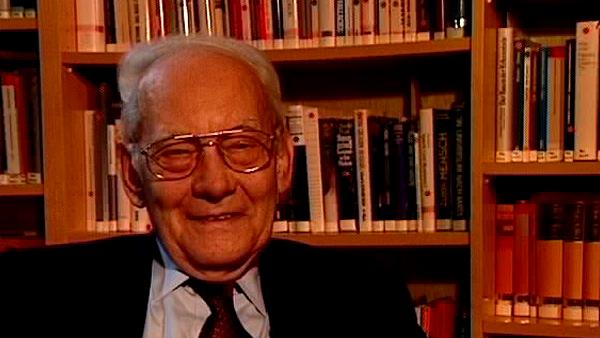NEXT STORY

Autocatalytic proteins in BSE
RELATED STORIES

NEXT STORY

Autocatalytic proteins in BSE
RELATED STORIES


|
Views | Duration | |
|---|---|---|---|
| 91. The versatility of viruses | 1 | 52 | 02:07 |
| 92. Polio: acceptance of errors | 45 | 02:13 | |
| 93. Virus detection methods | 42 | 03:56 | |
| 94. Prions are protein molecules not viruses | 51 | 02:14 | |
| 95. Autocatalytic proteins in BSE | 46 | 06:07 | |
| 96. Methods for early detection of prion diseases | 36 | 03:47 | |
| 97. Manfred Eigen and Ruthild Winkler's book The Laws of the... | 258 | 04:23 | |
| 98. The difference between chemical reactions and living systems | 76 | 03:32 | |
| 99. Why do we do research? | 64 | 02:18 | |
| 100. Talent | 110 | 00:43 |


It's a disease of the central nervous system and prions are the substances which cause this, but there was big surprise about the prions. Prions are not viruses, and it's almost certain now that there are no nucleic acids involved. Prions are protein molecules and most of the work... and the most important part of the work, has been done by Stan Prusiner in Berkeley in the United States and also by Charles Weissmann in Zurich and by Detlev Riesner in Dusseldorf. So what about the prions? Well, the prions are protein molecules. Alright, why not? Detlev Riesner in Dusseldorf, who is a former student of a student of mine, found out that there is almost... that he can pretty completely exclude the involvement of RNA, of nucleic acid. First of all, the infectious unit involves, I think, something like three hundred thousand molecules. So an infectious unit... it means that the protein as such is not very efficient but you need three hundred thousand whether the probability to find one among them is so low or whether you need a threshold - that has not yet been clarified. But the infectious unit involves many, many protein molecules and Detlev Riesner could show that in one infectious unit which involves many, many protein molecules there's less than one RNA of length of hundred base pairs. So that means there's no RNA. RNA can't play a major part in that.
Nobel Prize winning German biophysical chemist, Manfred Eigen (1927-2019), was best known for his work on fast chemical reactions and his development of ways to accurately measure these reactions down to the nearest billionth of a second. He published over 100 papers with topics ranging from hydrogen bridges of nucleic acids to the storage of information in the central nervous system.
Title: Prions are protein molecules not viruses
Listeners: Ruthild Winkler-Oswatitch
Ruthild Winkler-Oswatitsch is the eldest daughter of the Austrian physicist Klaus Osatitsch, an internationally renowned expert in gas dynamics, and his wife Hedwig Oswatitsch-Klabinus. She was born in the German university town of Göttingen where her father worked at the Kaiser Wilhelm Institute of Aerodynamics under Ludwig Prandtl. After World War II she was educated in Stockholm, Sweden, where her father was then a research scientist and lecturer at the Royal Institute of Technology.
In 1961 Ruthild Winkler-Oswatitsch enrolled in Chemistry at the Technical University of Vienna where she received her PhD in 1969 with a dissertation on "Fast complex reactions of alkali ions with biological membrane carriers". The experimental work for her thesis was carried out at the Max Planck Institute for Physical Chemistry in Göttingen under Manfred Eigen.
From 1971 to the present Ruthild Winkler-Oswatitsch has been working as a research scientist at the Max Planck Institute in Göttingen in the Department of Chemical Kinetics which is headed by Manfred Eigen. Her interest was first focused on an application of relaxation techniques to the study of fast biological reactions. Thereafter, she engaged in theoretical studies on molecular evolution and developed game models for representing the underlying chemical proceses. Together with Manfred Eigen she wrote the widely noted book, "Laws of the Game" (Alfred A. Knopf Inc. 1981 and Princeton University Press, 1993). Her more recent studies were concerned with comparative sequence analysis of nucleic acids in order to find out the age of the genetic code and the time course of the early evolution of life. For the last decade she has been successfully establishing industrial applications in the field of evolutionary biotechnology.
Tags: prions, nucleic acids, RNA, protein molecules, Stanley Benjamin Prusiner, Charles Weissmann, Detlev Heinz Riesner
Duration: 2 minutes, 15 seconds
Date story recorded: July 1997
Date story went live: 29 September 2010